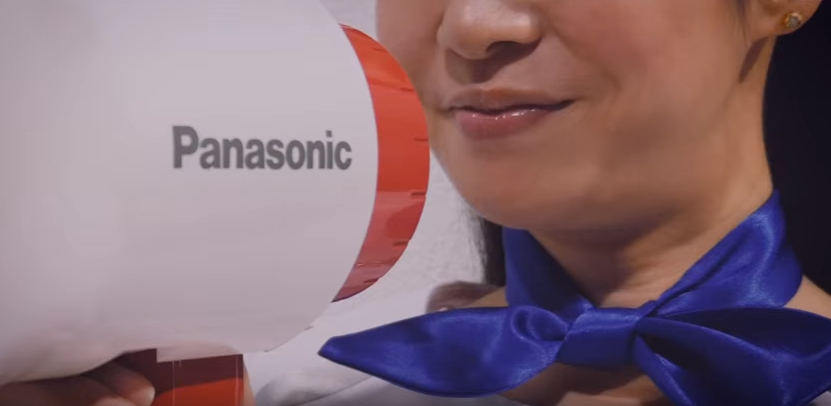Not long ago, Panasonic has introduced a new multilingual solution. This is a hybrid of a megaphone and PHABLET using the "Language Filter" principle. A user pronounces a word into the megaphone, then the device converts it to the selected language. The translated word then is played aloud by the megaphone.
Now, Panasonic engineers introduced two new concept of translators to be used in public places (airports, train stations, shopping centers), in tourist information centers. The devices can also serve as personal communication travelers.
A fixed translator will be indispensable in hotels, tourist information centers and service sector enterprises. The device, similar to a small table, consists of a large high-definition screen and two microphones for the conversation’s participants. Communication is accompanied by a display of maps and images. The translator can be customized for specific regions and objects, with names of specific areas of land and people's names added in the memory.
Latest development of Panasonic engineers is a "smart" pendant, or a portable auto translator, which can be worn around the neck.
Tomokazu Ishikawa, an engineer Panasonic Corporation, AVC Networks Company: "These devices share a common operating principle. So far, they support four languages: English, Chinese, Korean and Thai, but we will add more by 2020. We are developing an extended (text) database engine, which will be able to translate not only words, but whole sentences. This will improve accuracy of the translation by including a lot of colloquial and modern expressions."
A multi-device displaying signs and menus in multiple languages is another promising direction.
"TranslLet's! system uses a new 2D-code to upload information on smartphones. Unlike traditional 2D barcodes with complex shapes that can only be read from a short distance, the new barcodes will use only three colors - yellow, blue and purple. Placed on the screen, the sign, and any other surface, they can be read from different distances. In addition, applications and servers of TranslLet's! are synchronized, they collect and store information typed in users. It will allow stations and shops that use TranslLet's! system to analyze data about popular products, menus and events, and thus plan future activities", - said Takeshi Fujita, a specialist at Panasonic Solution Technologies’ business development department in the West Japan region.
Light ID will also help get information about a particular facility. The technology allows reading data from any object illuminated by LED light source. Turn on a special application, point the camera at the illuminated object, and you will learn more about the building.
This technology is useful, for example, in the retail sector, where limited space makes it physically impossible to translate signs in all languages of the world. With LED lighting showcases and illuminated signs, shop owners will be able to provide a "layering" of information, while maintaining a uniform style of trading halls decoration.
Now, Panasonic engineers introduced two new concept of translators to be used in public places (airports, train stations, shopping centers), in tourist information centers. The devices can also serve as personal communication travelers.
A fixed translator will be indispensable in hotels, tourist information centers and service sector enterprises. The device, similar to a small table, consists of a large high-definition screen and two microphones for the conversation’s participants. Communication is accompanied by a display of maps and images. The translator can be customized for specific regions and objects, with names of specific areas of land and people's names added in the memory.
Latest development of Panasonic engineers is a "smart" pendant, or a portable auto translator, which can be worn around the neck.
Tomokazu Ishikawa, an engineer Panasonic Corporation, AVC Networks Company: "These devices share a common operating principle. So far, they support four languages: English, Chinese, Korean and Thai, but we will add more by 2020. We are developing an extended (text) database engine, which will be able to translate not only words, but whole sentences. This will improve accuracy of the translation by including a lot of colloquial and modern expressions."
A multi-device displaying signs and menus in multiple languages is another promising direction.
"TranslLet's! system uses a new 2D-code to upload information on smartphones. Unlike traditional 2D barcodes with complex shapes that can only be read from a short distance, the new barcodes will use only three colors - yellow, blue and purple. Placed on the screen, the sign, and any other surface, they can be read from different distances. In addition, applications and servers of TranslLet's! are synchronized, they collect and store information typed in users. It will allow stations and shops that use TranslLet's! system to analyze data about popular products, menus and events, and thus plan future activities", - said Takeshi Fujita, a specialist at Panasonic Solution Technologies’ business development department in the West Japan region.
Light ID will also help get information about a particular facility. The technology allows reading data from any object illuminated by LED light source. Turn on a special application, point the camera at the illuminated object, and you will learn more about the building.
This technology is useful, for example, in the retail sector, where limited space makes it physically impossible to translate signs in all languages of the world. With LED lighting showcases and illuminated signs, shop owners will be able to provide a "layering" of information, while maintaining a uniform style of trading halls decoration.





